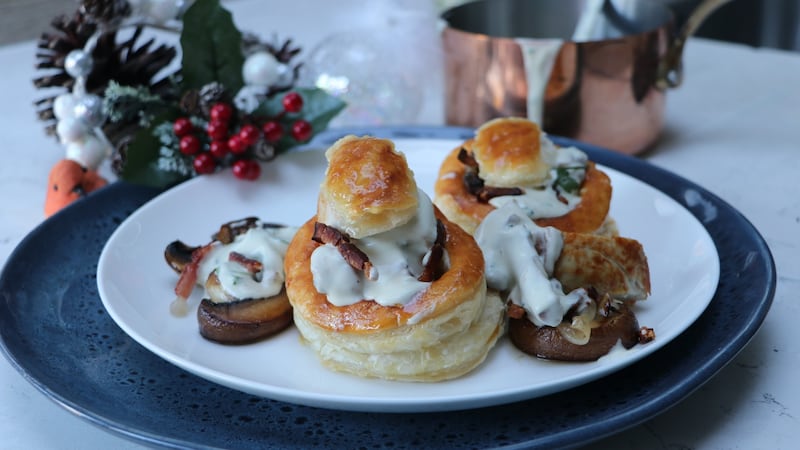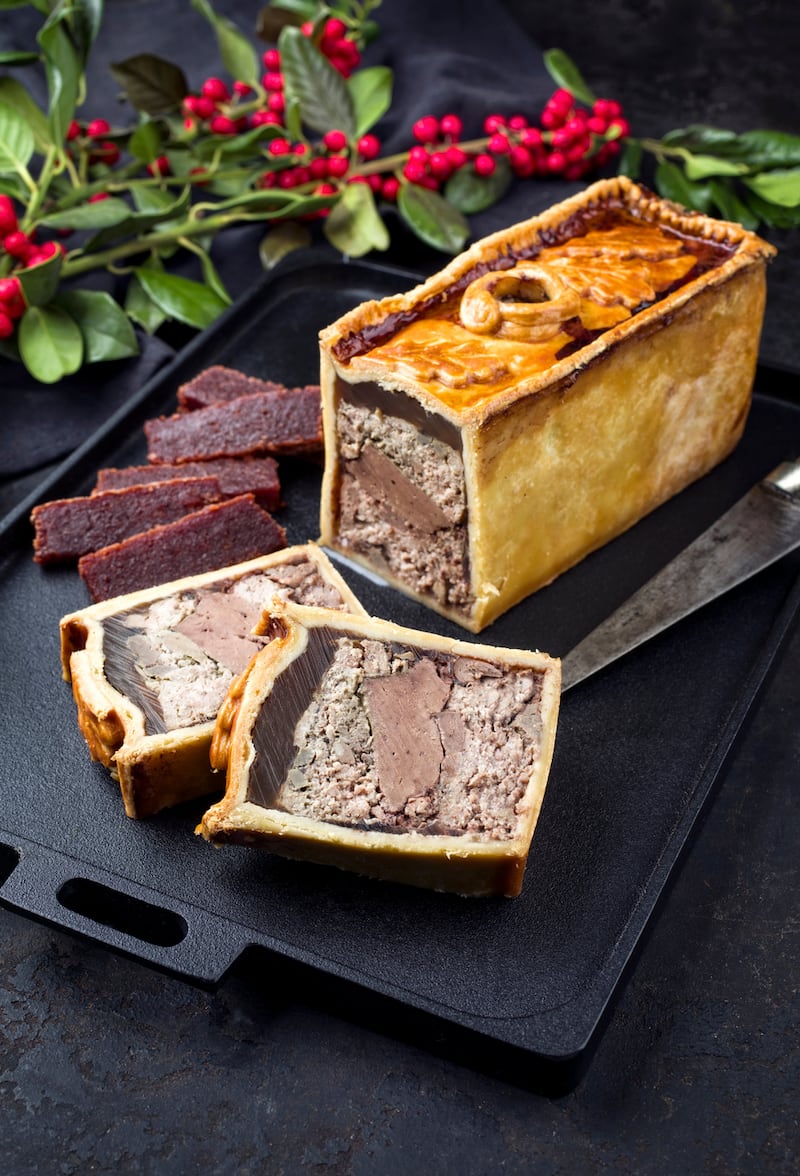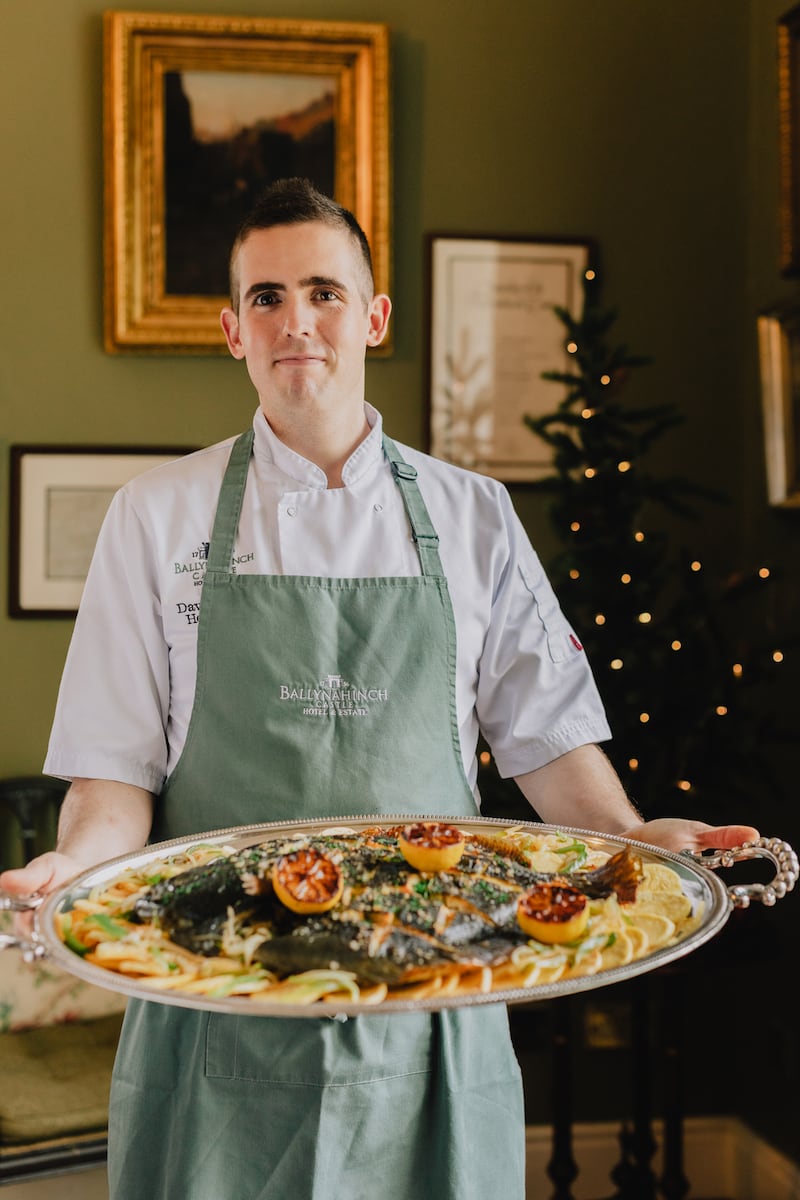CHICKEN AND MUSHROOM VOL-AU-VENTS
(Serves 6–12 depending on size of vol-au-vents)
Gaz Smith
Michael's of Mount Merrion
In my childhood home the Christmas Eve buffet was a bigger deal than Christmas Day lunch. We would fill the table with dozens of nibbles, and sit around chatting as extended family came and went. It was always so lovely to happily eat together as we shared gifts and greeted each other.
The chicken vol-au-vent was my personal favourite since a nipper, and I would often be caught sneaking an extra one or two. None of us could cook in our house, so the vol-au-vent cases were pre-bought and the chicken came out of a tin, but we loved them; they seemed so posh. Today I make my own filling but I still always use good shop-bought vol-au-vents for the case. There’s enough work in the béchamel and fillings, so save yourself the drama, which nobody needs at Christmas.

Ingredients
1 large packet of frozen vol-au-vent cases (I use Golden Bake or Jusroll, whichever size you prefer)
4 chicken breasts, boned, skinned and diced into 1cm cubes
1 small onion
1 small leek
150g mushrooms (button, field or snazzy wild mushrooms all work well)
50g bacon or pancetta, cut into lardons
Splash of brandy (and one for yourself)
Pinch of flat-leaf parsley, chopped
2 big pinches of fresh tarragon leaves, chopped

FOR THE WHITE SAUCE:
1 chicken stock cube
500ml milk
45g butter
55g flour
30ml fresh cream
Salt and pepper
Method
Before starting the white sauce, crumble the stock cube into the milk and gently heat – this will make it easier to keep a smooth sauce while bolstering the flavour.
Make a roux by combining the butter and flour in a pot and stirring continually and ever so gently over a low heat until the melted butter and flour have combined into a golden paste. Cook very gently for three to four minutes, constantly stirring. Once your paste looks like golden breadcrumbs, add the flavoured milk, salt and pepper and keep cooking on a very low heat, stirring constantly for about eight to 10 minutes. (I always play a couple of power ballads at this time. It’s vital to the recipe.) When your sauce is thickened, whisk in the cream and set aside.
In a large pot, sweat down the onions, pancetta and mushrooms over a gentle heat for five to 10 minutes until soft and golden. Increase the heat and carefully flambé the brandy: pour it into the hot pot and either tilt the pot to the gas flame or carefully and quickly use a lighter or long match – but take care not to burn yourself.
Add the chicken and Béchamel sauce and cook very gently for five minutes until the chicken is just cooked through. Add the fresh herbs and leave to cool slightly.
Preheat the oven as per the vol-au-vents packet instructions. Brush the vol-au-vents with egg yolk and bake in a preheated oven for 15-17 minutes until puffed-up and golden brown. Allow to cool before using a knife to pop off the inner lid, and provide a lovely void for your delicious filling.
Carefully spoon it in and pop the lid back on; remember, it’s a vol-au-vent, it’s never going to look like art, but it will be very comforting and delicious, just what you need of a winter’s evening.
These can be eaten straight away, but they are also really good left to cool and eaten when suits. I’ve been known to have them for breakfast the next day.
Other vol-au-vent fillings
Crab, prawn and tomato
Simply mix together crab meat and cooked prawns with a tomato-heavy Marie Rose sauce; you could even add a splash of brandy or vodka into the sauce to zing it up.
Smoked salmon and tzatziki
Simply shred smoked salmon into your baked vol-au-vents, top generously with tzatziki and season with a generous squeeze of lemon juice just before eating.
CHRISTMAS PÂTÉ EN CROUTE
Serves 8–10

Alex Petit
Head chef at Garden at Liss Ard Estate, Co Cork
I grew up in a small village in Brittany, where we used to gather at Christmas in my grandmother's farm barnyard, about 15 or 20 of us sitting around a huge table for at least three hours, which always seemed very long as a kid. My grandmother would serve her paté en croute as a showstopper starter that was loved by everyone, young and old.

This is her recipe, passed down through two generations and adapted to the Irish palate with local produce; I use Rosscarbery free-range pork and black pudding, Skeaghanore duck breast and Irish hazelnuts. We used to serve it with a Coteaux Champenois Bouzy Pinot Noir but served with any light and fruity red wine, it will start your Christmas feast on a winning note. It’s an elaborate recipe and a couple of hours work but worth the effort.
Ingredients
1.5kg minced free-range pork (½ pork belly, ½ sausage meat)
250g black pudding
200g duck breast
4 shallots
4 garlic cloves
50g unsalted butter
100ml dry white wine
150g Irish hazelnuts, skinned, chopped and toasted
1tbs chopped thyme
6g salt (1 level teaspoon)
1 pinch ground pepper
1 pinch five spice mix
2 eggs, beaten
FOR THE DOUGH/PASTRY:
500g flour
250g unsalted butter, softened and diced
10g salt
100g cold water
1 egg
FOR THE GELÉE (JELLY):
750ml white wine
750ml Madeira
10 leaves gelatine
2tbs chopped chives and chervil
Method
For the pork and black pudding filling, blitz the shallots and garlic in a food processor. Melt 25g butter in a saucepan, add the shallot mix and sweat off for three minutes while stirring but not allowing to colour. Add the dry white wine and reduce by half. Remove from the heat and allow to cool.
Trim the duck breast of fat and set aside for later. Chop the black pudding into small dice. In a large mixing bowl, combine with the pork mince, toasted nuts, herbs, seasoning and spices. Add the beaten eggs and the chilled reduced wine and mix until well combined.
To prepare the pâté en croûte dough, place the flour in a stand mixer, add the salt and then add the soft diced butter and one egg and mix well. Once incorporated, gradually add the water and bring together into a dough. On a lightly floured surface, roll out the pastry to a thickness of 0.5cm.
Grease the walls of a terrine mould with vegetable oil and line with the shortcrust pastry. Push half of the pork mix firmly to the bottom of the terrine. Cut the trimmed duck breast into long strips and lay these lengthways in your terrine. Add the remaining pork mix, pressing firmly.
Roll the leftover pastry to a thickness of ½cm. Cut a rectangle slightly larger than the tin and delicately place it over the minced pork. Pinch both pastries together to make sure they stick together. Cut three holes into the top layer of the pastry to allow the steam to escape while cooking, giving you space to pour the jelly into later.
Egg-wash the top of the terrine and bake the pâté en croûte in a preheated oven at 170 degrees for an hour and 25 minutes.
Meanwhile, to prepare the Madeira jelly, soak the gelatine leaves in iced water to soften. Combine the wine and Madeira in a saucepan and reduce over a medium heat to one litre. Remove from the heat and add the softened gelatine leaves.
When your pâté en croute is golden brown, remove from the oven and allow to cool a little in the mould. Once warm but not cold, pour over the liquid jelly through the three holes until it reaches the top. Reserve in the fridge until ready to serve.
ROASTED TURBOT WITH CONFIT POTATOES, PEPPERS AND ONIONS

David Bodas
Head Chef at Ballynahinch Castle Hotel
As with most Spaniards on December 25th, our family's table would be laden with canapés: foie gras terrines, fish rillettes, devilled eggs, chicken and mushroom vol-au-vents and a selection of soft cheeses – plus langoustine, crab or lobster served with an abundance of Marie Rose sauce and of course a large platter of Jamon Iberico.
This feast of canapés and seafood would be followed by a whole turbot roasted on the bone on a base of sliced potatoes, onions and green peppers, which have been soaking all the flavours and juices from the fish. This was served on a large silver tray as the table’s centrepiece and people served themselves.
Ingredients
1.5kg whole turbot (clean and gutted, ask your fishmonger to do this)
4 medium waxy potatoes, sliced into ½cm-thick slices, washed and dried
1 large white onion, sliced
1 green bell pepper, cored and sliced (optional)
4tbs olive oil
2 garlic cloves, sliced
2tbs cider vinegar
1 handful fresh parsley
1 pinch of salt
Method
Preheat the oven to 160 degrees.
Score and season the turbot and place it on a large tray lined with greaseproof paper. Roast in preheated oven for 25 minutes before increasing the temperature to 200 degrees and cooking for an extra 10 minutes to crisp up the skin.
Meanwhile, sweat the sliced onions and green pepper (if using) in olive oil for at least five minutes, until the onions are translucent and the peppers softened. Add the sliced potatoes, ensuring the oil covers the potatoes. Cook on a medium heat for about 15 minutes, until softened but not coloured.
Once the turbot is fully cooked, rest for a couple of minutes on the counter. Meanwhile, gently fry the two sliced garlic cloves in olive oil over a medium-low heat and pour this over the fish. In the same pan, add two tablespoons of cider vinegar, bring to the boil and pour over the fish.
To plate, display the potatoes and onions on a serving tray and place the turbot on top, pouring the remaining sauce on the fish tray. Finish with some finely chopped parsley.
CHRISTMAS PUDDING

Gráinne Mullins
Grá Chocolates
Christmas has always revolved around food in the Mullins household. Each of us are food lovers and we all have our own favourites. For my mother it's a slice of porter cake; for my father it's the Christmas pudding with brandy butter; my brother Luke is the king of the leftover sandwich; and for the rest of us it is the joy that the Christmas dinner brings (I am particularly fond of the ham).
Our Christmas cake doesn’t get cut open until Christmas Eve, when our visitors start to come by the house. My mother, Esther, will often make a very large cake just to share it with our neighbours or anyone else who might visit. And most importantly, we leave a slice for Santa Claus to eat when he climbs down the chimney.
Ingredients
250g organic sultanas
250g raisins
50g whole candied peel, finely chopped
25g whole almonds chopped (skin on is fine)
1 small cooking apple, cored and grated (no need to peel)
1 carrot, grated
Juice and grated zest of 1 large orange
Juice and grated zest of 1 large lemon
150ml stout
100ml brandy
1tbs treacle
130g self-raising flour
½ level tsp ground mixed spice
¼ level tsp freshly grated nutmeg
¼ level tsp cinnamon
Good pinch ground allspice
340g white breadcrumbs
225g butter, chopped
250g demerara sugar
2 large eggs
Method
Begin the day before you want to steam the pudding. In a large mixing bowl, add in all the dried fruit, peel and nuts followed by the apple, grated carrot and the juice and zest of the orange and lemon. Tick everything off as you go to make sure nothing gets left out. In another large bowl, mix together the stout, brandy and treacle. Pour this liquid over the dried fruits and mix together very thoroughly. Cover the bowl and leave overnight.
The next day, sieve the flour and spices together into a large mixing bowl. Add the breadcrumbs and the butter and use your fingertips to rub the flour and butter together until the mixture resembles breadcrumbs. Lift the mixture up as you rub it in so that the air going through it keeps it cool. Shake the bowl every so often to bring the larger lumps of butter to the surface. Stir in the sugar.
In a smaller bowl, beat the eggs thoroughly. Pour into the soaked fruit and mix very thoroughly.
Make a well in the centre of the breadcrumb mix and add all of the wet fruit mix. It’s now traditional to gather all the family around, especially the children, and invite everyone to have a really good stir and make a wish. The mixture should have a fairly sloppy consistency, falling instantly from the spoon when tapped on the side of the bowl. If it needs more liquid to loosen, add a spot more stout.
Pack the mixture into a large, lightly greased pudding bowl, cover with a double layer of baking parchment and a sheet of foil and tie securely with string (borrow someone’s finger for this), tying a piece of string across the top to make a handle. (If you prefer to make two smaller puddings, use two 570ml basins instead.) Place the pudding in a steamer set over a saucepan of simmering water and steam for eight hours. Keep a regular eye on the water levels, topping with boiling water from the kettle about halfway through the cooking. When the pudding is steamed, allow it to cool, then remove the baking parchment and foil and replace with fresh ones, again making a string handle for easy manoeuvring.
Store the pudding in a cool place away from the light until Christmas Day. We have often kept puddings for the following year should they be stored correctly.
On Christmas Day:
Place the pudding in a steamer over an almost-full pan of boiling, cover, reduce to a gentle simmer and leave to steam for two hours. Check the water from time to time and top it up as needed. When ready to serve the pudding, remove from the steamer and take off the wrapping, taking care not to burn yourself with the steam. Slide a palette knife all around the pudding and turn it out on to a warmed plate. Warm a ladleful of brandy over direct heat and, as soon as the brandy is hot, turn out the flame and ask someone to set light to the brandy using a long match.
Place the ladle, now gently flaming, on top of the pudding – but don’t pour it over until you reach the table. When you do, pour it slowly over the pudding, sides and all and watch it flame to the cheers of the assembled company. When both flames and cheers have died down, serve the pudding with brandy butter.
If you have any pudding left over, it will reheat beautifully, fried in a pan in the brandy butter.











